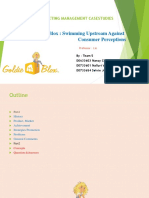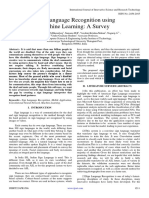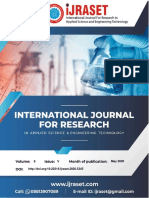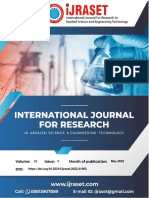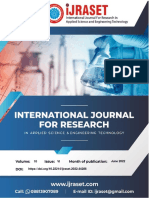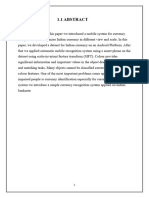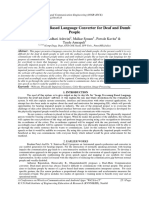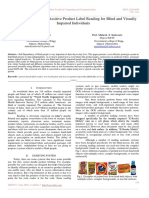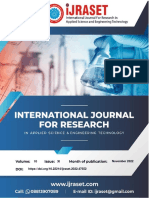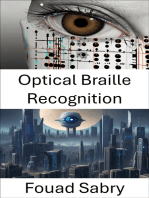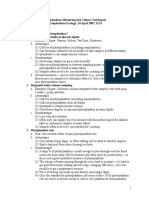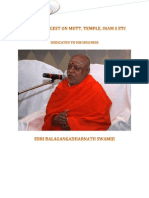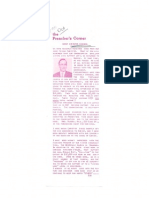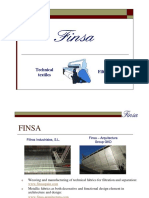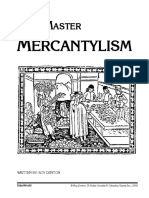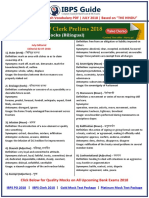Professional Documents
Culture Documents
A Review On Currency Classification and Image To Text Conversion Methodologies
A Review On Currency Classification and Image To Text Conversion Methodologies
Original Title
Copyright
Available Formats
Share this document
Did you find this document useful?
Is this content inappropriate?
Report this DocumentCopyright:
Available Formats
A Review On Currency Classification and Image To Text Conversion Methodologies
A Review On Currency Classification and Image To Text Conversion Methodologies
Copyright:
Available Formats
Volume 9, Issue 4, April – 2024 International Journal of Innovative Science and Research Technology
ISSN No:-2456-2165 https://doi.org/10.38124/ijisrt/IJISRT24APR275
A Review on Currency Classification and Image to
Text Conversion Methodologies
Naiknaware Reshma1 ; Nitin M.Shivale 2 ; Patil Shrishail3 ; Dr. Bhandari Gayatri4
Asst. Professor, Department of CSE, JSPM’s BSIOTR, Wagholi, Pune-412207.
2,3,4
1
Students, Department of CSE, JSPM’s BSIOTR, Wagholi, Pune-412207.
Abstract:- Currency classification and Image to Text measuring similarity, and ultimately recognizing the
OCR are essential technologies that find applications in character accurately.
various domains, including finance, retail, and
automation. The approach outlined in this paper has the Keywords:- Currency Recognition, CNN, OCR, Deep
potential to detect currencies from multiple countries. Learning.
However, for practical implementation purposes, the
focus is solely on Indian paper currencies. This system I. INTRODUCTION
offers the advantage of convenient currency checking at
any time and location, leveraging Convolutional Neural The World Health Organization (WHO) reports that
Networks (CNN) for effective implementation. Extensive globally, an estimated 285 million people are visually
testing was conducted on each denomination of Indian impaired, with the majority residing in developing nations.
currency, resulting in an impressive 95% accuracy rate. Among them, approximately 45 million individuals are
To further refine accuracy, a classification model was blind. Despite available solutions, none fully replicate the
developed, incorporating all pertinent factors discussed reading experience of sighted individuals, highlighting the
in the paper. Notably, the unique features of paper need for an affordable, portable text reader for the visually
currency play a pivotal role in the recognition process. impaired.
By emphasizing these elements and harnessing CNN
technology, the proposed system demonstrates significant A proposed solution involves creating a smart device
promise in accurately detecting and validating Indian with a multimodal system capable of converting any
paper currencies. It stands poised to serve various document into an accessible format. This device would
applications effectively. On the other hand, Image to enable blind individuals to read through tactile feedback and
Text OCR focuses on extracting text from images, auditory output via a text-to-speech engine, providing an
enabling the conversion of non- editable documents into experience akin to sighted individuals.
searchable and editable formats.
Visually impaired individuals encounter challenges in
Both technologies contribute to automation and daily tasks, including identifying items or information,
efficiency in handling diverse visual information. Optical leading to difficulties in navigating new environments. This
Character Recognition (OCR) is a technologydesigned to is especially problematic in scenarios like correctly
recognize and interpret both printed and handwritten identifying medications. Thus, innovative solutions such as
characters by scanning text images. This process involves smart devices and mobile applications are essential to
segmenting the text image into regions, isolating enhance accessibility and quality of life. Technology,
individual lines, and identifying each character along particularly mobile phones, plays a pivotal role in
with its spacing. After isolating individual characters facilitating communication and access to information for the
from the text image, the system conducts an analysis of visually impaired. Technologies like text-to-speech
their texture and topological attributes. This involves conversion and optical character recognition (OCR) enable
examining corner points, unique characteristics of effective interaction with computers through vocal
various regions within the characters, and calculating interfaces.
the ratio of character area to convex area Prior to
initiating recognition, the system creates templates that In conclusion, addressing challenges faced by visually
store the distinctive features of uppercase and lowercase impaired individuals in accessing information and
letters, digits, and symbols. navigating their environment is crucial. Innovative
technological solutions can significantly improve
These templates serve as reference models for accessibility and inclusion for this community.
comparison during the recognition phase. During
recognition, the system matches the extracted
character's texture and topological Features with those
stored in the templates to determine the exact character.
This matching process involves comparing features of
the extracted character with templates of all characters,
IJISRT24APR275 www.ijisrt.com 229
Volume 9, Issue 4, April – 2024 International Journal of Innovative Science and Research Technology
ISSN No:-2456-2165 https://doi.org/10.38124/ijisrt/IJISRT24APR275
II. BACKGROUND AND RELATED WORK denominations exhibit distinct patterns when viewed with
infrared vision due to varying amounts of infrared light in
The idea we're presenting isn't entirely original, different areas. To accommodate the size differences of
especially regarding the recognition of Indian currency. Indian rupees, sensors are strategically placed at the
Previous attempts have been made to tackle this challenge. beginning and end lengths of the note for accurate detection.
However, our approach seeks to streamline the currency
recognition process, making it more efficient and less
resource- intensive. We aim to develop a solution that can
operate effectively on lower-end computing devices. In this
section, we will review past efforts in this field, identifying
their shortcomings and outlining areas where improvements
can be made.
Traditional Method
The Scanning Module's Layout: Fig 1:- The layout for sensor placement is illustrated
The primary function of the sensing unit is to collect
data from the input bill and forward it to a processing In the scanning module, different colors signify various
module. There are six emitter-sensor pairs in all. Where denominations, and the circle inside each color denotes the
each infrared (IR) emitter is matched with a photosensor. placement of the sensor. The size of Indian currency notes
These pairs are integrated within the device, positioned are specified in Table1 and the scanning module's sensors
opposite each other on both sides of a bill that was inserted. comply with these requirements. The start of each note is
To provide accurate and consistentreadings, the emitters face indicated by the black barrier on the left. The dimensions of
upward and the photosensors are positioned downward a 1000 rupee note are represented by the outside black
toward the banknote. boundary, while the dimensions of 500, 100, 50, 20, and 10
rupee notes are represented by the colors yellow, green,
To provide accurate and consistent readings, the pink, red, and orange, respectively.
emitters face upward and the photosensors are positioned
downward toward the banknote. Different Indian rupee
Table 1. Dimensions and Color of Different Denominations
Numbering(in Rupees) Length in millimeters Width in millimeters Shade Forms
10 137 63 Orange Violet Not specified
20 147 63 Red Orange Not specified
50 147 73 Violet Not specified
100 157 73 Bluish Green Not specified
500 167 73 Olive and Yellow Not specified
1000 177 73 Pink Not specified
Pros: Provides tactile differentiation for various The next step for the system is to determine how
denominations, Simple and intuitive for blind individuals similar each feature is to the matching feature template
to use, doesn’t require additional equipment or linked to a certain denomination after it has been retrieved
technology, universally applicable to all blind from the input currency image. Higher similarity traits
individuals. receive a vote of one, whereas lower similarity features
Cons: Limited to physical currency only, doesn’t receive a vote of zero. The system then counts the number of
provide additional information like condition or features that got a single vote. If the count of features
authenticity. receiving a vote of one exceeds a certain threshold, the
currency is classified as known; otherwise, it is classified as
A. Feature Extraction unknown. The features extracted from the currency note are
Six unique characteristics are taken from each currency represented in Figure 2, while the architecture of the
note in the manner outlined for identifying paper money in proposed method is illustrated in Figure 3. This approach
Indian rupees. Two of these attributes are especially used to aims to effectively classify Indian rupee currency notes by
determine the currency's denomination, which helps the leveraging specific features and similarity calculations
system choose the right currency template.
IJISRT24APR275 www.ijisrt.com 230
Volume 9, Issue 4, April – 2024 International Journal of Innovative Science and Research Technology
ISSN No:-2456-2165 https://doi.org/10.38124/ijisrt/IJISRT24APR275
Fig 2: Interest Region at the Currency Images Fixed Position
Fig 3: The Paper Currency Recognition System's
Architecture
Pros: Accessibility for blind individuals, Reliability
and consistency, Cost-effective, Universal design,
Privacy preservation
Cons: Learning curve, Limited information provided,
Subject to wear and tear, Limited functionality,
Dependence on physical currency
Table 2. Table of Comparison:
Author/s Dataset Used Techniques/Methods- Used PerformanceMeasures
[ 1 ] Zhang & Yan(2018). Due to the lack of dataset,Self- 6-layer CNN Model Testing Accuracy:90%
generated data used.
[2] Kamble et al. (2019) Because of the absence of The proposed approach for finding of Accuracy of Testing:85.6%.
informational collection, self- fake note is grounded on CNN Accuracy of
creating it was obligatory.10, design. Preparing: 98.57%. Accuracy
000 picturesof every class were of Approval:96.55%.
produced. In this way, there Precision is:
were a sum of 40,000 pictures 85.8%
Review: 86.00%
[3] Pokala & Teja(2020) Data Collection for development Image processing code usingBrute Testing Accuracy: Poor
of, the imageProcessing code. Force Matcher algorithm
Data-set used is Indiancurrency. VGG16 Convolutional Neural k-N-N and D-T-C
The data-set comprises many Network (ConvNets)
[4] Nijil Raj N (2020) Indian currencie’sof, Rs20, Accuracy of Testing:99.7%.
Rs50, Rs100, Rs200, Rs500. ‘SVM’ and
‘BC’ Accuracy ofTesting:
100%.
[5] Raghad RaiedMahmood , Self-built Iraqi bank notedataset YOLOv3 model Accuracy – 97.405 %
Dr. Majid DherarYounus
(2021)
B. Need of Proposed System: C. Research Gap
Currency classifications are driven by the urgent needs The main aspect or challenge in the currency recognition
of our fast-paced, modern society. These technologies are is accuracy.
motivated by several important elements that solve pressing
To achieve the accuracy many of system uses different
issues and seize chances to increase accessibility, accuracy,
algorithms.
and efficiency. Automated currency classification eliminates
the need for human counting and verification by ensuring These system ensure for currency recognition but not the
quick and error-free transaction processing. This reduces the accuracy.
possibility of errors brought on by human participation while Currency recognition and currency detection plays an
also speeding up financial activity’s technology converts important for these kind of system.
scanned documents or photos into editable, searchable text
automatically. For companies that deal with a lot of D. Existing System:
paperwork, this is revolutionary since it makes data Commercial Currency Sorters: Financial institutions
extraction, information retrieval, and document and businesses use currency sorting machines that
management. incorporate image processing and pattern recognition
IJISRT24APR275 www.ijisrt.com 231
Volume 9, Issue 4, April – 2024 International Journal of Innovative Science and Research Technology
ISSN No:-2456-2165 https://doi.org/10.38124/ijisrt/IJISRT24APR275
algorithms. These machines can identify and sort different in documents and photos. Tesseract supports multiple
denominations based on various features, such as size, color, languagesand can be customized for specific
and security features. applications.
ATMs (Automated Teller Machines): ATMs are Adobe Acrobat OCR: Adobe Acrobat includes OCR
equipped with currency recognition capabilities to functionality for converting scanned documents into
authenticate and handle banknotes of different editable and searchable text. It is commonly used for
denominations. These systems employ a combination of document management anddigitization.
sensors and image processing techniques.
III. PROPOSED SYSTEM
Retail Automation Systems: Some retail environments
use automated systems that can recognize and process Develop and train an advanced machine learning model
various currencies during transactions, providing for currency classification. Utilize deep learning techniques,
efficiency and accuracy in cash handling. such as convolutional neural networks (CNNs), to improve
the system's ability to recognize various currencies,
Google Cloud Vision OCR: This OCR feature allows including different denominations and security features.
you to extract text from documents and images on Implement state-of-the-art OCR algorithms, including those
Google Cloud. It supports multiple languages, and the based on deep learning architectures, to improve the
extracted text can be used for various applications, such accuracy of text extraction from images. Consider
as document analysis and content indexing. techniques like attention mechanisms for handling complex
document layouts.
Tesseract OCR: Google created Tesseract, an open-
source OCR engine. It is frequently used to identify text System Architecture Currency Classification:
Fig 4: System architecture
Convolutional Neural Networks Certainly! Here’s OCR Algorithm: Optical Character Recognition (OCR)
Convolutional Neural Net- works (CNNs) encode images is a computer vision process used for detecting and
into vector representations: interpreting text within images. It plays a vital role in
enabling Natural Language Processing algorithms to
Input Image: CNNs take an image as input. comprehend the content of documents.
Convolutional Layers: They use filters to extract features Input Layer: This layer consists of grayscale images
like edges and shapes. Activation Function: Apply representing text-containing documents. Output Layer:
functions to capture complex relationships. The identified text or characters are indicated by
binary or multi-class labels produced by the output
Pooling Layers: Down-sample to retain key information. layer.
Flattening: Convert feature maps into a1D vector.
Secret Layers: A fully connected neural network,
Fully Connected Layers: Capture relationships and pooling layers, ReLU (rectified linear unit) layers, and
output a vector. convolutional layers are some examples of these layers.
Output: The final vector represents the image and is used It's crucial to remember that Artificial Neural Networks
for tasks like classification and object detection. (ANNs), which are made up of many neurons, cannot
directly extract features from pictures. Convolutional and
IJISRT24APR275 www.ijisrt.com 232
Volume 9, Issue 4, April – 2024 International Journal of Innovative Science and Research Technology
ISSN No:-2456-2165 https://doi.org/10.38124/ijisrt/IJISRT24APR275
pooling layers are used to address this. Though these layers [7]. Ms. Seema A. Dongare , Prof. Dhananjay B.
are quite good at extracting features, they are not appropriate Kshirsagar, Ms. Snehal V. Waghchaure, Handwritten
for jobs involving categorization. For categorization, a fully Devanagari Character Recognition using Neural Net-
linked neural network is therefore required. Understanding work, IOSR Journal of Computer Engineering (IOSR-
each section independently is crucial before delving further JCE) e-ISSN: 2278- 0661, p- ISSN: 2278-8727 Vol-
into these ideas. ume 16, Issue2, Ver. X (Mar-Apr.2014), PP 74-79 .
[8]. Mitrakshi B. Patil, Vaibhav Narawade, Recognition of
IV. CONCLUSION Handwritten Devna- gari Characters through
Segmentation and Arti cial neural networks, Interna-
In summary, the investigation of the categorization of tional Journal of Engineering Research and Technology
cash demonstrates their significant influence on a number of (IJERT) Vol. 1 Issue 6, August- 2012. ISSN: 2278-
facets. These innovations in machine learning and image 0181.
processing are revolutionizing the way we engage with [9]. Mandeep Kaur, Sanjeev Kumar, A RECOGNITION
visual data, streamlining workflows, and improving SYSTEM FOR HAND- WRITTEN GURMUKHI
accessibility. By automating the identification and CHARACTERS, International Journal of Engineer- ing
management of various currencies, currency classification Research and Technology (IJERT) Vol. 1 Issue 6,
simplifies cross-border trade, retail operations, and financial August - 2012 ISSN: 2278-0181.
transactions technology increases productivity by [10]. Miroslav NOHAJ, Rudolf JAKA, Image preprocessing
streamlining document management. Reducing manual labor for optical character recognition using neural networks,
and mistakes is achieved by data extraction and the Journal of Patter Recognition Research, 2011.
transformation of images into editable and searchable text. [11]. Nisha Sharma , Recognition for handwritten English
Systems for classifying currencies are essential to letters: A Re- view, In- ternational Journal of
international trade because they facilitate smooth Engineering and Innovative Technology (IJEIT)
transactions and eliminate obstacles brought on by currency Volume 2, Issue 7, January 2013.
variability. By enabling people with visual impairments to [12]. J.Pradeep, Diagonal based feature extraction for
access printed and handwritten information, OCR improves handwritten alphabets recog- nition System using
financial inclusion and fosters an inclusive digital neural network, International Journal of Computer Sci-
environment. ence and Infor- mation Technology (IJCSIT), Vol 3,
No 1, Feb 2011.
REFERENCES
[1]. Yu Weng, Chunlei Xia, A New Deep Learning-Based
Handwritten Character Recognition System on Mobile
Computing Devices. Mobile Networks and Appli-
cations, 2019.
[2]. Gunjan Singh,Sushma Lehri, Recognition of
Handwritten Hindi Characters using Back propagation
Neural Network, International Journal of Computer
Science and Information Technologies ISSN 0975-
9646, Vol. 3 (4) , 2012.
[3]. S S Sayyad, Abhay Jadhav, Manoj Jadhav, Smita
Miraje, Pradip Bele, Avinash Pandhare, Devnagiri
Character Recognition Using Neural Networks,
Interna- tional Journal of Engineering and Innovative
Technology, (IJEIT)Volume 3, Issue 1, July 2013.
[4]. Shabana Mehfuz,Gauri katiyar, Intelligent Systems for
O -Line Handwritten Character Recognition: A
Review, International Journal of Emerging Technol-
ogy and Advanced Engineering Volume 2 , Issue 4,
April 2012.
[5]. Prof. Swapna Borde, Ms. Ekta Shah, Ms. Priti Rawat,
Ms. Vinaya Patil, Fuzzy Based Handwritten Character
Recognition System ,International Journal of Engi-
neering Research and Applications (IJERA), ISSN:
2248-9622,VNCET 30 Mar12.
[6]. Na z Arica and Fatos T. Yarman-Vural, An Overview
of Character Recognition Focused on O-Line
Handwriting, IEEE transactions on systems, man, and
cy- bernetics part applications and reviews, VOL. 31,
NO. 2, MAY 2001.
IJISRT24APR275 www.ijisrt.com 233
You might also like
- Copy B-To Be Filed With Employee's FEDERAL Tax Return. Copy 2-To Be Filed With Employee's State, City, or Local Income Tax ReturnDocument1 pageCopy B-To Be Filed With Employee's FEDERAL Tax Return. Copy 2-To Be Filed With Employee's State, City, or Local Income Tax ReturntabithaNo ratings yet
- Marketing Case Study Case5 Goldieblox 12 Maret 2019 1080312Document31 pagesMarketing Case Study Case5 Goldieblox 12 Maret 2019 1080312Amin Akasyaf50% (2)
- Sign Language Recognition Using Machine Learning A SurveyDocument5 pagesSign Language Recognition Using Machine Learning A SurveyInternational Journal of Innovative Science and Research TechnologyNo ratings yet
- PHStat2 ReadmeDocument5 pagesPHStat2 ReadmeAnkur GuptaNo ratings yet
- Chapter Ii: Research Design and MethodologyDocument6 pagesChapter Ii: Research Design and MethodologyJohn Dominic Delos ReyesNo ratings yet
- Implementation of Authenticity and Nomin 4c8969b2Document4 pagesImplementation of Authenticity and Nomin 4c8969b2azzalea alkanzaNo ratings yet
- Indian Paper Currency Recognition With Audio Output System For Visually Impaired Based On Image Processing Using Transfer LearningDocument9 pagesIndian Paper Currency Recognition With Audio Output System For Visually Impaired Based On Image Processing Using Transfer LearningIJRASETPublicationsNo ratings yet
- A Novel Approach For Morse Code Detection From Eye Blinks and Decoding Using OpenCVDocument8 pagesA Novel Approach For Morse Code Detection From Eye Blinks and Decoding Using OpenCVIJRASETPublicationsNo ratings yet
- Counterfeit Currency Detection Based On AIDocument8 pagesCounterfeit Currency Detection Based On AIIJRASETPublicationsNo ratings yet
- Real-Time Sign Language Detection and RecognitionDocument7 pagesReal-Time Sign Language Detection and RecognitionIJRASETPublicationsNo ratings yet
- Currency Denomination Identifier ApplicationDocument8 pagesCurrency Denomination Identifier ApplicationIJRASETPublicationsNo ratings yet
- A Survey On Sign Language Recognition With Efficient Hand Gesture RepresentationDocument7 pagesA Survey On Sign Language Recognition With Efficient Hand Gesture RepresentationIJRASETPublicationsNo ratings yet
- A Model For Sign Language Recognition System Using Deep LearningDocument9 pagesA Model For Sign Language Recognition System Using Deep LearningIJRASETPublicationsNo ratings yet
- Sign Language Detection With CNNDocument6 pagesSign Language Detection With CNNIJRASETPublicationsNo ratings yet
- Android Based Indian Currency Recognition System Using Transfer Learning TechniqueDocument7 pagesAndroid Based Indian Currency Recognition System Using Transfer Learning TechniqueIJRASETPublicationsNo ratings yet
- Multi-Lingual Sign Language Detection SystemDocument5 pagesMulti-Lingual Sign Language Detection SystemIJRASETPublicationsNo ratings yet
- Si-Lang Translator With Image ProcessingDocument4 pagesSi-Lang Translator With Image ProcessingInternational Journal of Innovative Science and Research TechnologyNo ratings yet
- Currency Recognition Blind Walking StickDocument3 pagesCurrency Recognition Blind Walking StickIJIRSTNo ratings yet
- Sign Language Recognition and Converting Into TextDocument8 pagesSign Language Recognition and Converting Into TextIJRASETPublicationsNo ratings yet
- Trinetra: An Assistive Eye For The Visually ImpairedDocument6 pagesTrinetra: An Assistive Eye For The Visually ImpairedInternational Journal of Innovative Science and Research TechnologyNo ratings yet
- Hand Gestures Classification and Image Processing Using Convolution Neural Network AlgorithmDocument6 pagesHand Gestures Classification and Image Processing Using Convolution Neural Network AlgorithmInternational Journal of Innovative Science and Research TechnologyNo ratings yet
- A Survey Paper On Sign Language Recognition System Using OpenCV and Convolutional Neural NetworkDocument7 pagesA Survey Paper On Sign Language Recognition System Using OpenCV and Convolutional Neural NetworkIJRASETPublicationsNo ratings yet
- Ijaerv13n10 194Document8 pagesIjaerv13n10 194taehyung kimNo ratings yet
- Currency Detection For Blind PeopleDocument19 pagesCurrency Detection For Blind Peoplehaffah1245No ratings yet
- Currency Recognition System For Visually Impaired Ijariie4599Document6 pagesCurrency Recognition System For Visually Impaired Ijariie4599Sarah Jean TrajanoNo ratings yet
- Improve The Recognition Accuracy of Sign Language GestureDocument7 pagesImprove The Recognition Accuracy of Sign Language GestureIJRASETPublicationsNo ratings yet
- Denominations 2Document4 pagesDenominations 2Kumar KumarNo ratings yet
- Motion-Sensing Home Automation With VocalizationDocument7 pagesMotion-Sensing Home Automation With VocalizationInternational Journal of Innovative Science and Research TechnologyNo ratings yet
- Gesture Language Translator Using Raspberry PiDocument7 pagesGesture Language Translator Using Raspberry PiIJRASETPublicationsNo ratings yet
- Object Detection Methodologies For Blind PeopleDocument5 pagesObject Detection Methodologies For Blind PeopleEditor IJRITCCNo ratings yet
- Image Processing Based Language Converter For Deaf and Dumb PeopleDocument6 pagesImage Processing Based Language Converter For Deaf and Dumb PeopleAnonymous Ndsvh2soNo ratings yet
- JETIRDV06004Document3 pagesJETIRDV06004George WelsonNo ratings yet
- Hand Sign An Incentive-Based On Object Recognition and DetectionDocument5 pagesHand Sign An Incentive-Based On Object Recognition and DetectionInternational Journal of Innovative Science and Research TechnologyNo ratings yet
- Real Time Video Recognition of Signs For Deaf and Dump Using Deep LearningDocument5 pagesReal Time Video Recognition of Signs For Deaf and Dump Using Deep LearningIJRASETPublicationsNo ratings yet
- Muhammad 2019 J. Phys. Conf. Ser. 1402 044016Document7 pagesMuhammad 2019 J. Phys. Conf. Ser. 1402 044016Muhammad YusroNo ratings yet
- Bank Notes Authentication System Based On Wavelet Features and Artificial Neural NetworkDocument5 pagesBank Notes Authentication System Based On Wavelet Features and Artificial Neural NetworkKishan Bhat KNo ratings yet
- Intelligent Sign Language Recognition Using ImageDocument8 pagesIntelligent Sign Language Recognition Using ImageECE Department at SBCENo ratings yet
- Detection of Fake Currency Using Machine LearningDocument9 pagesDetection of Fake Currency Using Machine LearningIJRASETPublicationsNo ratings yet
- An Embedded Real Time Finger Vein Recognition System For ATMDocument7 pagesAn Embedded Real Time Finger Vein Recognition System For ATMerpublicationNo ratings yet
- An Automated Recognition of Fake or Destroyed Indian Currency Notes (Review)Document5 pagesAn Automated Recognition of Fake or Destroyed Indian Currency Notes (Review)IJASRETNo ratings yet
- MULTIPLE COLOR DETECTION IN REAL - TIME USING PYTHON (Paper) PDFDocument7 pagesMULTIPLE COLOR DETECTION IN REAL - TIME USING PYTHON (Paper) PDFP NagarajanNo ratings yet
- A Survey On Real Time Sign Language Detector Using MLDocument11 pagesA Survey On Real Time Sign Language Detector Using MLIJRASETPublicationsNo ratings yet
- Handwritten Character RecognitionDocument22 pagesHandwritten Character RecognitionIJRASETPublicationsNo ratings yet
- Sign Language Recognition System Using Deep LearningDocument5 pagesSign Language Recognition System Using Deep LearningInternational Journal of Innovative Science and Research TechnologyNo ratings yet
- Vision Based Banknote Recognition SystemDocument6 pagesVision Based Banknote Recognition SystemIJRASETPublicationsNo ratings yet
- Sign Language Detector Using CloudDocument5 pagesSign Language Detector Using CloudEditor IJTSRDNo ratings yet
- Ijirt147616 PaperDocument7 pagesIjirt147616 PaperShridhar MDNo ratings yet
- Portable Camera Based Assitive Product Label Reading For Blind and Visually Impaired IndividualsDocument3 pagesPortable Camera Based Assitive Product Label Reading For Blind and Visually Impaired IndividualsEditor IJRITCCNo ratings yet
- Iris Recognition System Using Matlab: A Project ReportDocument47 pagesIris Recognition System Using Matlab: A Project Reportmaverick12342No ratings yet
- Conversion of Sign Language Video To Text andDocument8 pagesConversion of Sign Language Video To Text andIJRASETPublicationsNo ratings yet
- Handwritten English Alphabet RecognitionDocument8 pagesHandwritten English Alphabet RecognitionIJRASETPublicationsNo ratings yet
- Ijet V3i5p15Document6 pagesIjet V3i5p15International Journal of Engineering and TechniquesNo ratings yet
- T A D G G V V: HE Mazing Igital Loves That IVE Oice To The OicelessDocument10 pagesT A D G G V V: HE Mazing Igital Loves That IVE Oice To The OicelesszeeshanNo ratings yet
- Speaking System For Mute PeopleDocument4 pagesSpeaking System For Mute PeopleInternational Journal of Innovative Science and Research TechnologyNo ratings yet
- Real-Time Product Recognition and Currency Detection in Supermarket For Visually ImpairedDocument6 pagesReal-Time Product Recognition and Currency Detection in Supermarket For Visually ImpairedSanket JadhavNo ratings yet
- Sign Language Detection Using CNNDocument5 pagesSign Language Detection Using CNNIJRASETPublicationsNo ratings yet
- Universal Currency Identifier and Fake Note Detection For Indian CurrenciesDocument5 pagesUniversal Currency Identifier and Fake Note Detection For Indian CurrenciesInternational Journal of Innovative Science and Research TechnologyNo ratings yet
- Computer Vision Based Virtual Illustration Using OpenCVDocument7 pagesComputer Vision Based Virtual Illustration Using OpenCVIJRASETPublicationsNo ratings yet
- Real Time Sign Language RecognitionReal Time Sign Language RecognitionDocument7 pagesReal Time Sign Language RecognitionReal Time Sign Language RecognitionIJRASETPublicationsNo ratings yet
- IJARCCE3J S Pandimadevi Implementation of Attendance Management System Using SMART FRDocument5 pagesIJARCCE3J S Pandimadevi Implementation of Attendance Management System Using SMART FRSai BhumaNo ratings yet
- SeminarpDocument43 pagesSeminarppranati prasadNo ratings yet
- CurrencydetectionDocument26 pagesCurrencydetectionRozeena MaharjanNo ratings yet
- Optical Braille Recognition: Empowering Accessibility Through Visual IntelligenceFrom EverandOptical Braille Recognition: Empowering Accessibility Through Visual IntelligenceNo ratings yet
- Neural Networks for Beginners: Introduction to Machine Learning and Deep LearningFrom EverandNeural Networks for Beginners: Introduction to Machine Learning and Deep LearningNo ratings yet
- Human Resource Functions: Examining Insights from ABC Research OrganizationDocument9 pagesHuman Resource Functions: Examining Insights from ABC Research OrganizationInternational Journal of Innovative Science and Research TechnologyNo ratings yet
- Conceptualized Fusion Reactor based on Gas Turbine with High Temperature CO2Document7 pagesConceptualized Fusion Reactor based on Gas Turbine with High Temperature CO2International Journal of Innovative Science and Research TechnologyNo ratings yet
- The Expanding Attack Surface: Securing AI and Machine Learning Systems in Security OperationsDocument8 pagesThe Expanding Attack Surface: Securing AI and Machine Learning Systems in Security OperationsInternational Journal of Innovative Science and Research Technology100% (1)
- Personal Capabilities of The Non-Teaching Personnel and Client SatisfactionDocument8 pagesPersonal Capabilities of The Non-Teaching Personnel and Client SatisfactionInternational Journal of Innovative Science and Research TechnologyNo ratings yet
- The Impact of the Commercial Agriculture Credit Scheme (CACS) on the Agricultural Economy of Nigeria and its Total Output (2015-2019)Document8 pagesThe Impact of the Commercial Agriculture Credit Scheme (CACS) on the Agricultural Economy of Nigeria and its Total Output (2015-2019)International Journal of Innovative Science and Research TechnologyNo ratings yet
- Teacher-Induced Academic Stress: Predicting Eating Behavior Problems in College StudentsDocument8 pagesTeacher-Induced Academic Stress: Predicting Eating Behavior Problems in College StudentsInternational Journal of Innovative Science and Research TechnologyNo ratings yet
- Modern Approaches to Sustainable AgricultureDocument10 pagesModern Approaches to Sustainable AgricultureInternational Journal of Innovative Science and Research Technology100% (1)
- Integrating Quantum Algorithms with Gravitational-Wave Metrology for Enhanced Signal DetectionDocument18 pagesIntegrating Quantum Algorithms with Gravitational-Wave Metrology for Enhanced Signal DetectionInternational Journal of Innovative Science and Research Technology100% (1)
- Utilizing Chicken Eggshells and Waste Glass Powder as Cement Fillers for Environmental StabilityDocument6 pagesUtilizing Chicken Eggshells and Waste Glass Powder as Cement Fillers for Environmental StabilityInternational Journal of Innovative Science and Research TechnologyNo ratings yet
- The Impact of Termite Activity on the Availability of Soil Micronutrients in Tropical RegionsDocument6 pagesThe Impact of Termite Activity on the Availability of Soil Micronutrients in Tropical RegionsInternational Journal of Innovative Science and Research Technology100% (1)
- Assessment of Integrated Poultry Manure and Synthetic Fertilizer Effects on Maize (Zea mays) Growth and Soil Properties: A Study from Bayero University, KanoDocument15 pagesAssessment of Integrated Poultry Manure and Synthetic Fertilizer Effects on Maize (Zea mays) Growth and Soil Properties: A Study from Bayero University, KanoInternational Journal of Innovative Science and Research Technology100% (1)
- Study of prevalence of Head Lice (Pediculus Humanus Capitis) Among Schoolchildren in the Zawiya Region, LibyaDocument10 pagesStudy of prevalence of Head Lice (Pediculus Humanus Capitis) Among Schoolchildren in the Zawiya Region, LibyaInternational Journal of Innovative Science and Research Technology0% (1)
- Transforming Challenges to Victories: An Inquiry on Transformational Leadership of School Leaders in the Public Elementary SchoolsDocument54 pagesTransforming Challenges to Victories: An Inquiry on Transformational Leadership of School Leaders in the Public Elementary SchoolsInternational Journal of Innovative Science and Research TechnologyNo ratings yet
- Meta Land: Redefining Virtual Communities Through Centralized Governance, Inclusivity and InnovationDocument5 pagesMeta Land: Redefining Virtual Communities Through Centralized Governance, Inclusivity and InnovationInternational Journal of Innovative Science and Research TechnologyNo ratings yet
- Development of Smart Ground Fault Location Model For Radial Distribution SystemDocument14 pagesDevelopment of Smart Ground Fault Location Model For Radial Distribution SystemInternational Journal of Innovative Science and Research TechnologyNo ratings yet
- Solar Based Multilevel Inverter F o R BLDC Motor DriveDocument8 pagesSolar Based Multilevel Inverter F o R BLDC Motor DriveInternational Journal of Innovative Science and Research TechnologyNo ratings yet
- Design and Development of Multi-Featured Medical StretcherDocument4 pagesDesign and Development of Multi-Featured Medical StretcherInternational Journal of Innovative Science and Research TechnologyNo ratings yet
- The Influence of Continuance Commitment on Job Satisfaction of Barangay Health Workers in Malaybalay City, BukidnonDocument14 pagesThe Influence of Continuance Commitment on Job Satisfaction of Barangay Health Workers in Malaybalay City, BukidnonInternational Journal of Innovative Science and Research TechnologyNo ratings yet
- Seasonal Variation and Distribution Patterns of Endophytic Community in Withania SomniferaDocument7 pagesSeasonal Variation and Distribution Patterns of Endophytic Community in Withania SomniferaInternational Journal of Innovative Science and Research TechnologyNo ratings yet
- Exploring The Potential Advantages of Traditional Therapies in Autoimmune Blistering Illnesses: A Comprehensive Review and Analysis, ResearchDocument12 pagesExploring The Potential Advantages of Traditional Therapies in Autoimmune Blistering Illnesses: A Comprehensive Review and Analysis, ResearchInternational Journal of Innovative Science and Research TechnologyNo ratings yet
- Intelligent Clinical Documentation: Harnessing Generative AI For Patient-Centric Clinical Note GenerationDocument15 pagesIntelligent Clinical Documentation: Harnessing Generative AI For Patient-Centric Clinical Note GenerationInternational Journal of Innovative Science and Research TechnologyNo ratings yet
- Strategic Deployment of Ducklink Wireless Devices For Disaster Mitigation and Management in Nueva ECIJA University of Science and Technology Sumacab CampusDocument13 pagesStrategic Deployment of Ducklink Wireless Devices For Disaster Mitigation and Management in Nueva ECIJA University of Science and Technology Sumacab CampusInternational Journal of Innovative Science and Research TechnologyNo ratings yet
- Skin Disease Detection and Remedial SystemDocument7 pagesSkin Disease Detection and Remedial SystemInternational Journal of Innovative Science and Research TechnologyNo ratings yet
- Application of Plant Growth Promoting Rhizobacteria On Vegetative Growth in Chili Plants (Capsicum Frutescens L.)Document7 pagesApplication of Plant Growth Promoting Rhizobacteria On Vegetative Growth in Chili Plants (Capsicum Frutescens L.)International Journal of Innovative Science and Research TechnologyNo ratings yet
- Reading Intervention Through "Brigada Sa Pagbasa": Viewpoint of Primary Grade TeachersDocument3 pagesReading Intervention Through "Brigada Sa Pagbasa": Viewpoint of Primary Grade TeachersInternational Journal of Innovative Science and Research TechnologyNo ratings yet
- Unlocking Sentiments: Enhancing IOCL Petrol Pump ExperiencesDocument8 pagesUnlocking Sentiments: Enhancing IOCL Petrol Pump ExperiencesInternational Journal of Innovative Science and Research TechnologyNo ratings yet
- EmoConnect: Nurturing Trust and Relationship Bonds in Alzheimer's ConversationsDocument3 pagesEmoConnect: Nurturing Trust and Relationship Bonds in Alzheimer's ConversationsInternational Journal of Innovative Science and Research TechnologyNo ratings yet
- Fall Detection and Boundary Detection in Care HomesDocument7 pagesFall Detection and Boundary Detection in Care HomesInternational Journal of Innovative Science and Research TechnologyNo ratings yet
- Smart and Secure Home With ChatbotDocument9 pagesSmart and Secure Home With ChatbotInternational Journal of Innovative Science and Research TechnologyNo ratings yet
- Preparation and Identification of Magnetic Iron Nanoparticle Based On A Natural Hydrogel and Its Performance in Targeted Drug DeliveryDocument17 pagesPreparation and Identification of Magnetic Iron Nanoparticle Based On A Natural Hydrogel and Its Performance in Targeted Drug DeliveryInternational Journal of Innovative Science and Research TechnologyNo ratings yet
- SQL DBM - Google SearchDocument3 pagesSQL DBM - Google SearchPrftest apteanNo ratings yet
- Phyto TechniquesDocument13 pagesPhyto TechniquesIsmail JabbarNo ratings yet
- Unit - 2: Selected Micro - Teaching Skills: StructureDocument33 pagesUnit - 2: Selected Micro - Teaching Skills: StructurelingarajugowdaNo ratings yet
- Case Law Digest On Mutt Disputes and The Inam - Archak - Temple MattersDocument73 pagesCase Law Digest On Mutt Disputes and The Inam - Archak - Temple MattersSridhara babu. N - ಶ್ರೀಧರ ಬಾಬು. ಎನ್100% (4)
- Danikas Christos Georgia 1971 GreeceDocument3 pagesDanikas Christos Georgia 1971 Greecethe missions networkNo ratings yet
- Unit 3 - Family To World Family OrderDocument76 pagesUnit 3 - Family To World Family OrderONLINE hapurNo ratings yet
- WWW Courses Psu Edu Biol Biol110 - hw7 Dihybrid HTM PDFDocument2 pagesWWW Courses Psu Edu Biol Biol110 - hw7 Dihybrid HTM PDFnareshyadavNo ratings yet
- Case Study AnalysisDocument41 pagesCase Study AnalysiskdcandariNo ratings yet
- Annotated BibliographyDocument3 pagesAnnotated Bibliographyapi-235151902No ratings yet
- SOCY 122 Intramural Course Outline and Winter Term Readings 2018Document12 pagesSOCY 122 Intramural Course Outline and Winter Term Readings 2018caduzinhoxNo ratings yet
- Pillar#1B-1: Classification of Financial Intermediaries: Bank & NBFCDocument27 pagesPillar#1B-1: Classification of Financial Intermediaries: Bank & NBFCThe Hindu100% (1)
- Presentacion FinsaDocument25 pagesPresentacion FinsaEngineering Office ShahrakNo ratings yet
- Padilla vs. MagduaDocument14 pagesPadilla vs. MagduaFairyssa Bianca SagotNo ratings yet
- Mr. Muhammad RazaDocument20 pagesMr. Muhammad RazasheerNo ratings yet
- Sold To The Sheik Alexx AndriaDocument34 pagesSold To The Sheik Alexx AndriaWu WeiNo ratings yet
- LMIC-v4 1 0Document27 pagesLMIC-v4 1 0David duranNo ratings yet
- Restaurant-Daily Sales ReportDocument3 pagesRestaurant-Daily Sales ReportSatu Dua Coffee & RestoNo ratings yet
- Agad YogasDocument32 pagesAgad YogasRahul PasrichaNo ratings yet
- Batok (Traditional Tattoos) in DiasporaDocument27 pagesBatok (Traditional Tattoos) in DiasporaAlvin HalconNo ratings yet
- Mercan TylerDocument64 pagesMercan Tylerduchessjack100% (2)
- Edgar Heap of Birds by Bill AnthesDocument42 pagesEdgar Heap of Birds by Bill AnthesDuke University PressNo ratings yet
- Student Internship Activity Report FormDocument4 pagesStudent Internship Activity Report FormFinancetronix Innovatronix100% (1)
- Newest Catalog For Aluminium ProfilesDocument51 pagesNewest Catalog For Aluminium Profilesdreman13No ratings yet
- Bank Exam English Vocabulary PDF - July 2018Document26 pagesBank Exam English Vocabulary PDF - July 2018venkatnadh kolapalliNo ratings yet
- Tome of Battle Maneuver CardsDocument38 pagesTome of Battle Maneuver CardsThomas SeveriniNo ratings yet

